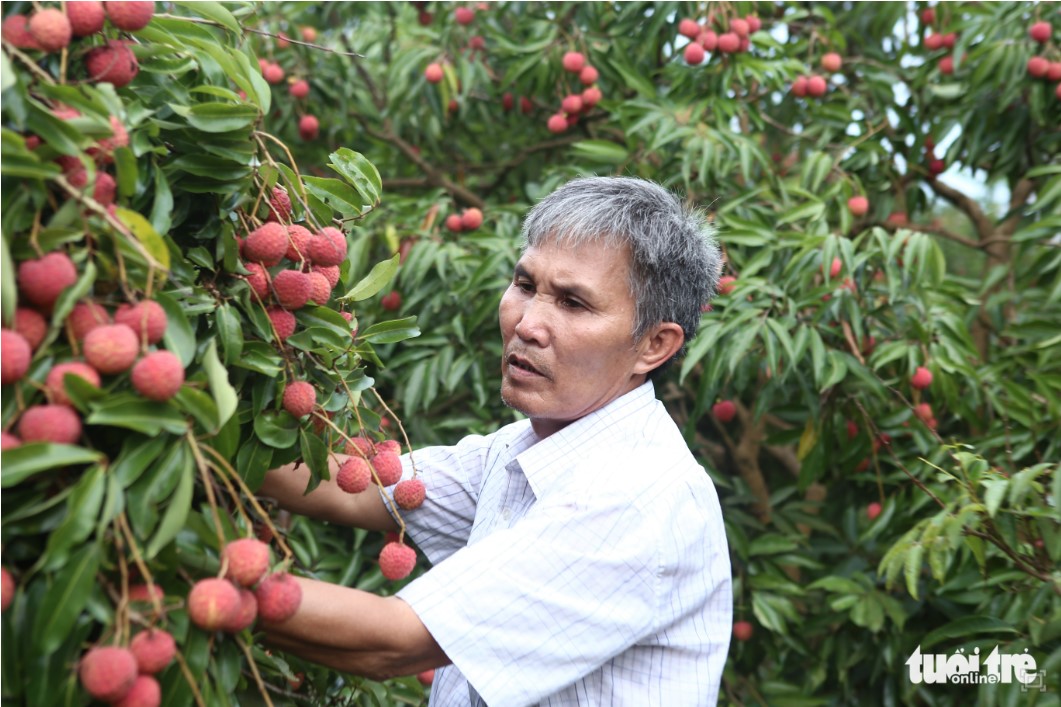To avoid complete dependence on China, Vietnamese lychee farmers used this year’s harvest as an opportunity to expand their footprint across the globe by exporting to over 30 international markets, as well as strengthening their domestic position.
During this year’s lychee harvest season, which typically falls over summer, Vietnam’s lychee famers have been focusing their efforts on selling to industrial parks and shipping their products to Japan, the U.S., and several other countries, rather than relying primarily on China, a long-standing market, to purchase their fruit.
In a discussion with Tuoi Tre (Youth) newspaper, Truong Van Nam, vice-chairman of the People’s Committee of Luc Ngan District in the northern province of Bac Giang, said that this year’s lychee crop has been exported to more than 30 countries and territories other than China, adding that all of the lychees grown in Luc Ngan meet standards set forth by VietGAP and GlobalGAP.
Agricultural products certified under VietGAP, GlobalGAP, and other equivalent standards are often easily accepted by large distributors and big markets.
Luc Ngan District has found ways to ships its famous fruits to other provinces and industrial parks because of China’s strict restrictions and regulations on fighting the COVID-19 pandemic, Nam said.
Bac Giang Province, along with Hai Duong Province, is perhaps the most well-known province in Vietnam in terms of lychee production.
This year, Bac Giang had a particularly successful lychee crop capable of meeting various market demands.
“Many groups have signed contracts with the district to buy lychees,” said Nam.
“Given our nation’s population of around 100 million people, we will easily sell the entire crop even if each individual buys just one kilogram of lychees,,” he added.
Among the province’s signed contracts, The Vietnam National Textile and Garment Group, also known as Vinatex, has been committed to buying lychees for its three million workers.
Labor unions and women’s associations across Vietnam have made commitments to buy the fruit.
In the long term, Bac Giang’s farmers and fruit export companies plan to diversify their markets instead of merely focusing on the Chinese market as they did in the past.
A kilogram of high-quality lychees fetches VND5,000-7,000 (US$0.21-0.30) higher than normal quality fruits thanks to both its appearance and health benefits, according to Chu Xuan Ba, a lychee farmer from Giap Son Commune in Luc Ngan District.
“Normally my family invests VND100-120 million [$4,290-5,147] in each crop," Ba said.
"Last year, we sold just 50 percent of our output and the rest rotted owing to the COVID-19 pandemic.
"It was a big financial burden on us.
"We had mainly sold our lychees to Chinese traders."
In Ba’s opinion, farmers who grow lychees may find it relatively difficult to sell the fruits this year because of the COVID-19 pandemic.
Ba hopes that the government will support farmers like him with promotive policies such as supplying low-interest bank loans for periods of five or seven years, rather than one-year loans as they did in the past.
He wishes for support in the facilitation of moving export trucks over the border and helping farmers access more freezers to preserve their harvested fruits, as well as to more online shops where they can sell their crops.
Luc Ngan vice-chairman Nam said that local authorities are asking farmers to follow official guidelines for growing and packaging lychees for export.
“We have consulted the provincial authorities of Bac Giang to be able to help the farmers, especially with facilities which produce ice and spongy materials, as well as to construct more ovens for drying lychees," he revealed.
"If we have difficulty in exporting lychees, our farmers can take advantage of the ovens to dry the fruits [for sale through other channels]."
As of June 27, Luc Ngan’s lychees had been sold primarily to southern provinces and in supermarkets and stores in Hanoi and other northern provinces and cities.
The lychees have been exported to Cambodia through Tay Ninh Province’s Moc Bai international border gate and An Giang Province’s Tinh Bien border gate.
They have also been shipped to China through the Huu Nghi international border gate in Lang Son Province.
As of the time of writing, Luc Ngan has sold around 15,585 metric tons of lychees domestically and 16,946 tonnes on the international market, of which the Chinese accounted for 97 percent.
This year, the price of lychees started at VND14,000-28,000 ($0.60-1.20) per kilogram in the early season and currently sits at VND15,000-25,000 ($0.64-1.07) per kilogram.
The Bac Giang lychee has become a famous brand both at home and abroad.
The fruit has been exported to more than 30 countries and territories, including such demanding markets as the U.S., Japan, and the EU, making it one of Vietnam’s staple exports.
Like us on Facebook or follow us on Twitter to get the latest news about Vietnam!



















































